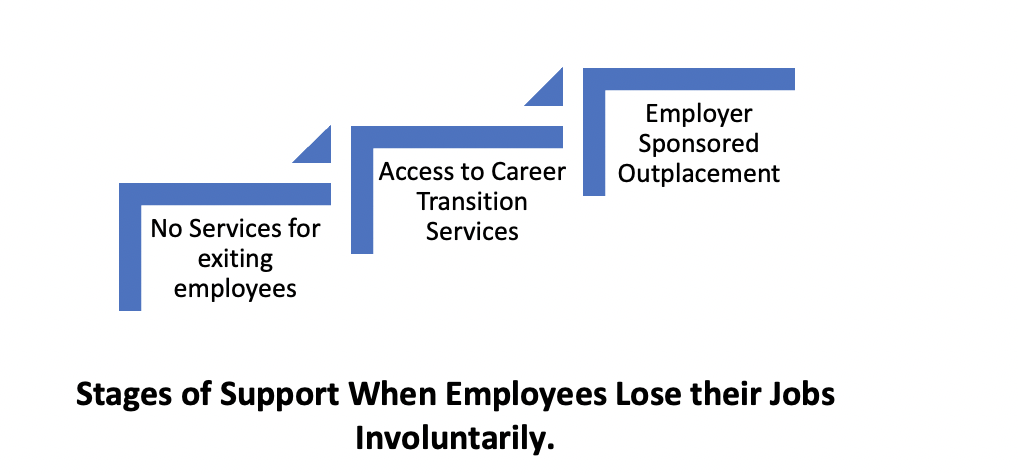Outplacement and Career Transition Benefits Promote the Bottom Line
April 7, 2021By Gene Mills Gallivan, MS
Whether you call it reorganization, right-sizing, termination, downsizing, layoff, reorganization or restructuring, turnover is daunting for both the organization and the individuals involved.
In today’s environment, leaders are challenged to create clear strategies to manage workforce reductions that address both employee and job candidate inquiries should they be displaced through no fault of their own. Leaders that respond with a clear message of support regarding career transition or full-service outplacement can minimize employee feelings of anger and betrayal and promote the bottom line for both the company, existing employees and those who will depart.

NO SERVICE IS NOT AN OPTION
Receiving no resources for re-employment is an experience many people encounter when they exit a company involuntarily. Doing nothing as the employer does not mean the impact on the bottom line has been minimized. When there is no budget for career transition or outplacement, low employee morale, disengagement, mistrust, unexpected turnover, lawsuits, and even workplace violence may develop. At a minimum, every employer can show empathy and suggest carefully researched local career transition options during the exit interview to offset impacts of job loss.
CAREER TRANSITION SERVICES
Companies that do not have a full outplacement benefit in place may want to consider partnering with a career transition firm to provide partial or fully paid access for exiting employees. This partnership can be as simple as a referral to qualified resources that employees can engage personally. It may be a partnership in which the employer utilizes and pays a career transition firm to provide career coaching and consulting for exiting employees.
Potential Benefits of Career Transition Services when Paid for by the Job Candidate:
- Support to find work quickly while easing stress and worry
- Resource for creation of a full career plan in addition to the resume
- Access to experts in the field
Additional Benefits when Paid for by the Company:
- Promotes engagement, productivity, loyalty and satisfaction of employees who remain
- Preserves the company’s reputation during difficult times
- Decreases risk of legal action
- Impacts unemployment costs
- Acts as a resource in attracting talent
OUTPLACEMENT IS AN EMPLOYEE BENEFIT THAT BOOSTS THE BOTTOM-LINE
When faced with the reality of providing benefits for your employees, having sound practices regarding an outplacement process may not be what you think of first. However, a comprehensive approach to outplacement is just as important to your employee’s peace of mind as the benefits reflected in health, retirement, and 401K’s. The impact of your outplacement guidelines are experienced directly by separated employees, noted by remaining employees, and observed by the community.
Before partnering with a career transition firm, consider the scope and the length of their program services. Select partnerships that include support in areas such as:
- Managing Emotions During Transition
- Career and Strengths Assessment
- Identification of Alternative Careers
- Entrepreneurial Options
- Career Development
- Social Media
- Resume Development
- Referrals to Placement Firms
- Network Development
- Negotiation Approaches
- Onboarding in New Job
CHOOSING AN EXTERNAL PARTNER
Whether you are considering consulting a professional firm for career transition or for a full range of consulting services regarding outplacement, there are many factors to consider.
A reputable career transition and outplacement firm is a resource in termination planning, designing severance packages, preparation of services on the employee’s final day, initiating EAP services with adversely impacted employees, initiating career transition services, resume development, utilization of social media, navigation of the interview process, salary negotiation and onboarding in the new role. You may also want to consider the human resources, legal, coaching and health/wellness services they can provide to allow employees that remain to better manage the stress of internal reorganization and the increased demand in their daily routines.
ADDITIONAL FACTORS TO CONSIDER
- Nimbleness
Today, one size fits all approaches may seem helpful, but often they do not address the many nuances of outplacement and career transition. Investigate the ability of outside sources to customize their solutions to fit your business model and the needs of the candidates being served.
- Technology
Simply put, what is the technology part of the provider’s solution? How do they address the increasing demands of social media, video interactions, and internet job banks in their solution?
- Focus
Does the provider specialize in outplacement or is it a secondary service option? External providers that have built their reputations offering outplacement and career transition as the core service may have a more enthusiastic approach to this very challenging career dilemma.
- Size
In today’s market, accessibility to the provider is critical. A national provider makes sense if the scope of your employee displacement is national or international. However, a regional firm can make financial sense and provide a personal touch if the outplacement is localized.
- Cost
The expense of career transition programs and outplacement services is an investment. Negotiate services that provide maximum benefit for your pocketbook. Remember, the costs can be offset for both the employer and the job candidate by minimizing the time from job loss to rehire.
SUMMARY
Turnover is a challenging issue within every company. Part of dealing with this challenge is determining the long-term impacts and degree of external support to provide employees when they leave the company. Whether it is basic empathy and a recommendation to a pre-screened career transition provider or a robust employee outplacement benefit, every company can do something.
*Gene Gallivan is a retired human resources executive and executive coach with over 30 years experience within the non-profit, business and education sectors. He remains active in his field as a writer, course designer, instructor, and part-time coach/consultant with Golden Career Strategies in Greenville, S.C.

















